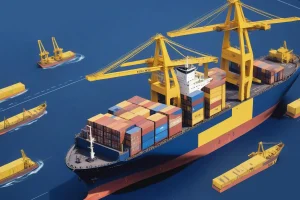This post is also available in:
![]() فارسی (Persian)
فارسی (Persian)
In today’s world, international transportation plays a vital role in global trade, and one of the main methods of cargo transportation is the use of containers. Containers, as one of the important inventions of the 20th century, have created a great revolution in the transportation industry and have been able to significantly facilitate global trade by increasing speed, reducing costs, and improving security. In this article, from the knowledge guide of container types, we comprehensively review the advantages of using containers in cargo transportation, the methods of cargo transportation with containers, and related reforms.
The importance of container shipping
Container shipping, as one of the basic and widely used methods in the international shipping industry, has a significant impact on global trade. The use of containers in cargo transportation, due to its many advantages, has spread rapidly around the world and has played an important role in facilitating and improving logistics processes.
Key advantages of using containers in cargo transportation
- 1. Increasing efficiency and speed in transportation
Containers make the loading and unloading process much faster and more efficient due to their standardized dimensions and design. This has led to a reduction in the time of stopping at the ports and acceleration in the movement of cargoes, and ultimately reduces the overall transportation time.
- 2. Reducing costs
The use of containers reduces operational costs due to higher productivity and reduced need for multiple cargo handling. In addition, reducing downtime and speeding up logistics processes also lowers maintenance and warehousing costs.
- 3. Improving cargo security
Due to their strong and resistant structure, containers protect cargo from physical damage and adverse weather conditions. Also, the possibility of locking containers and installing various security systems minimizes the risks associated with theft and unauthorized access to cargo.
- 4. Ease of transfer and intermodal transfer
Containers are designed in such a way that they can be easily moved between different modes of transportation (sea, rail, road and air) without the need to unload and reload cargo. This issue reduces costs and time of intermodal transfer.
- 5. Increasing the load carrying capacity
Due to the optimal use of the internal space of containers and their stack loading capability in ships and warehouses, the cargo carrying capacity increases significantly. This advantage is very important, especially in sea transportation that needs to carry a large amount of cargo.
- 6. Reduction of damages and losses
Due to their standard and resistant structure, containers minimize the risks associated with cargo damage during transportation. This issue reduces financial losses and losses for cargo owners and transport companies.
- 7. Compatibility with new technologies
Containers are compatible with new technologies such as GPS tracking systems and temperature and humidity sensors. These facilities allow logistics managers to closely monitor the status and position of shipments and take necessary actions quickly if needed.
Types of containers and the use of each in the transportation industry
The use of containers in international transportation is very popular due to their versatility and high efficiency. Each type of container is designed for specific applications and has unique features that make it suitable for carrying different types of cargo.
In the following, we will introduce and use several types of containers:
1. Standard containers
Standard containers, which are also called dry containers, are the most common type of containers used in cargo transportation. These containers are typically available in 20-foot and 40-foot sizes and are used to transport general and dry cargo.
Applications:
- Carrying general goods such as household appliances, clothing, electronics and non-perishable food;
- Use in international and intermodal transportation (sea, rail, road);
- Temporary warehouse for storing goods.
summary
Container transportation, as one of the main methods of moving cargo in the international arena, plays a vital role in facilitating global trade. This method has been rapidly spread around the world due to its many advantages, including cost reduction and increased efficiency and security. Familiarity with container terminology is an important part of understanding and managing international shipping. These terms are part of a common language used among industry players and help facilitate communication and processes.
Choosing the right shipping method and type of container depends on the type of cargo, destination, budget and your specific needs. According to the information presented in this “Knowledge Guide” blog, you can make better decisions in the field of international shipping and benefit from the benefits of container shipping. By considering these factors and knowing the terms and methods available, you can manage your business more confidently and achieve more success.


Comments